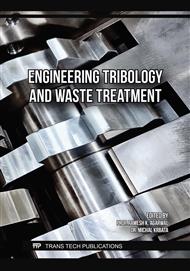p.61
p.71
p.77
p.83
p.89
p.97
p.103
p.109
p.117
Optimized Adsorption of Aqueous Cu (II) Ions Using Novel Microwave-Extracted Sodium Alginate from Brown Seaweed (Sargassum sp.)
Abstract:
Brown seaweed (Sargassum sp.) is one of the most abundant biomass wastes widely available along the Philippine coast and has potential for alginate production. This alginate is a natural polysaccharide, having potential properties in adsorbing contaminants, such as heavy trace metals, through to its properties. In this study, pure sodium alginate (Na-ALG) was extracted and characterized from Sargassum sp. via modified Microwave-Assisted Extraction (MAE), an inexpensive and efficient method for extraction. The Cu (II) ion adsorption capability of the extracted Na-ALG in an aqueous solution was also investigated to address the increasing levels of harmful metals (i.e. Cu) on the coast of Batangas, Philippines. The novel extraction process yielded 44.0±10.8% Na-ALG, with desirable physicochemical properties. Also, Na-ALG’s surface morphology, functionalities, and crystallinity index attested to its capability to adsorb contaminants, such as heavy metals, which is through the presence of pores, functional groups of COO-, and semi-crystalline structures, resulting in adsorption-surface complexation, ionic exchange, and electrostatic interactions. Moreover, the adsorption parameters of Cu (II) concentration, Na-ALG dosage, contact time, and pH were investigated and optimized using the Response Surface Methodology Central Composite Design (RSM-CCD). The optimized adsorption process resulted in a metal concentration of 30 mg/L, alginate dosage of 2.5 g, contact time of 120 min, and pH of 3, exhibiting good adsorption efficiency of 35.96%. Thus, the results proved the adsorption efficiency based on each parameter, and the relationship of the Na-ALG properties to its Cu (II) ion adsorption capability in an aqueous medium. Conclusively, this study showed that Na-ALG extracted from Sargassum sp. via MAE can efficiently adsorb Cu (II) ions in aqueous solutions.
Info:
Periodical:
Pages:
97-102
Citation:
Online since:
June 2025
Price:
Сopyright:
© 2025 Trans Tech Publications Ltd. All Rights Reserved
Share:
Citation:


